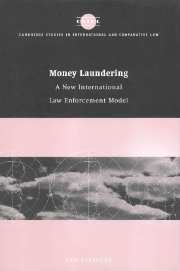Book contents
- Frontmatter
- Contents
- Preface
- Table of treaties and agreements
- List of abbreviations
- Part I New instruments in the fight against acquisitive crime: confiscation of proceeds from crime and criminalisation of money laundering
- Part II The prevention of money laundering
- Part III Jurisdiction over money laundering
- Part IV International co-operation in combating money laundering
- 11 The money laundering regime: new objectives of international co-operation in criminal matters
- 12 The money laundering regime: new modes of international evidence-gathering
- 13 Some of the conditions, principles and exceptions of mutual judicial assistance in criminal matters revisited
- 14 Lifting banking secrecy in an international context
- 15 Provisional measures for preserving alleged proceeds of crime in an international context
- 16 International enforcement of confiscation orders
- Epilogue
- Bibliography
- Index
- CAMBRIDGE STUDIES IN INTERNATIONAL AND COMPARATIVE LAW
15 - Provisional measures for preserving alleged proceeds of crime in an international context
Published online by Cambridge University Press: 16 October 2009
- Frontmatter
- Contents
- Preface
- Table of treaties and agreements
- List of abbreviations
- Part I New instruments in the fight against acquisitive crime: confiscation of proceeds from crime and criminalisation of money laundering
- Part II The prevention of money laundering
- Part III Jurisdiction over money laundering
- Part IV International co-operation in combating money laundering
- 11 The money laundering regime: new objectives of international co-operation in criminal matters
- 12 The money laundering regime: new modes of international evidence-gathering
- 13 Some of the conditions, principles and exceptions of mutual judicial assistance in criminal matters revisited
- 14 Lifting banking secrecy in an international context
- 15 Provisional measures for preserving alleged proceeds of crime in an international context
- 16 International enforcement of confiscation orders
- Epilogue
- Bibliography
- Index
- CAMBRIDGE STUDIES IN INTERNATIONAL AND COMPARATIVE LAW
Summary
The term ‘provisional measure’ is used here to denote the large range of measures that exist under municipal law, such as seizure, freezing, restraint orders, sequestrations, etc., that are designed to enable the preservation of alleged proceeds of crime, or of legitimate assets which may be used for executing a (value) confiscation order. This relatively new type of seizure should be distinguished from the more traditional type of seizure with which most criminal justice systems are familiar and which is intended to preserve elements of proof. Whereas the latter type of seizure belongs to the realm of investigatory measures, the former is a provisional measure. Of course, there are also completely different types of provisional measure, namely those that are designed to ensure that the suspect will not abscond such as provisional arrest. Hereinafter the term ‘provisional measures’, however, will exclusively refer to measures that are taken to ensure that assets are preserved with a view to the enforcement of a possible confiscation.
Both the Vienna Convention (Article 5(2)) and the Money Laundering Convention (Article 7(2)) require parties to adapt their domestic legislation in order to introduce provisional measures. The availability of this type of provisional measure that allows the prevention of the dissipation of assets during the investigation or pending trial is indeed a prerequisite for any attempt at an effective fight against money laundering and acquisitive crime in general. In order to act effectively, it is obviously necessary to do so without warning the person concerned, which explains why provisional measures in the context of a criminal investigation are taken ex parte, or, in continental European law systems, unilaterally by an investigating magistrate or public prosecutor.
- Type
- Chapter
- Information
- Money LaunderingA New International Law Enforcement Model, pp. 352 - 380Publisher: Cambridge University PressPrint publication year: 2000

